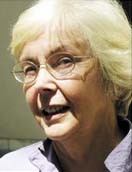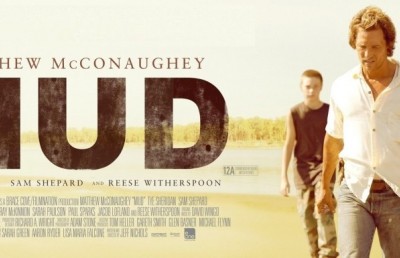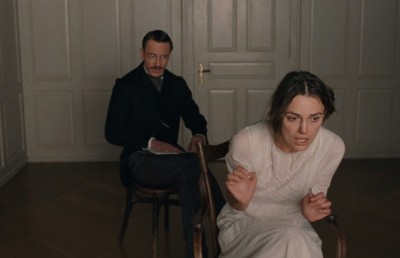The 69th Venice International Film Festival: Women Emerge—or Do they?
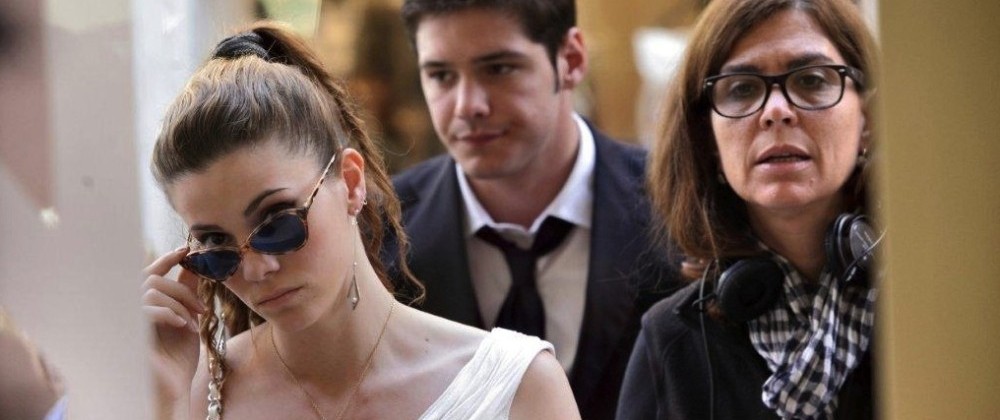
Returning to head up the 2012 Venice Festival after a 10-year hiatus, Alberto Barbera put the spotlight on women with a scaled-down program featuring a generous sampling of movies made by female directors in addition to a panel devoted to the issue of women’s films. Barbera’s decision to focus on women was a timely one, for the rival Cannes event has had no women filmmakers in its main competition in two out of the last three years. Nor is Cannes unique. Martha Lauzen’s Center for the Study of Women in Television and Film at San Diego State University recently tracked the representation of female filmmakers at twenty-two major American film festivals; they found that women helmed only 23% of all narrative features at these events. Nor are film festivals the worst culprits. Hollywood’s record in recent years is even more dismal. When Lauzen computed the percentage of top-grossing Hollywood productions helmed by women, she put the figure at 5%—half of what it was in 1998. In a putatively post-feminist era when bestselling books announce the end of men, such statistics are mindboggling.
What is lost when women are so far shut out? There are no absolutes here. Kathryn Bigelow’s Academy Award triumph for The Hurt Locker in 2010 scotched essentialist gender stereotypes, proving that women can be as adept at handling male-dominated action pictures as men. And James L. Brooks’s 1984 Oscar win for Terms of Endearment showed that men are able to direct outstanding female-centered melodramas. Still, even while the creative reach of women and men filmmakers stretches across the full range of genres and subject matter, it is undoubtedly the case that women are more likely to be drawn towards material that features female characters and plots centered around the domestic sphere even as men prefer to focus on men. When Lauzen’s Center tracked the top-grossing Hollywood films of 2011, she found that only 11% of all protagonists in these films were female. And there are surely statistical differences in the kinds of female heroes men and women directors tend to favor and the ways in which they choose to portray them.
The female-authored films I saw in Venice contained numerous tidbits that captured under-the-radar issues about women’s experiences, including the embarrassment suffered by young girls who are sent to buy sanitary napkins (Inheritance Héritage [Hiam Abbas], and the danger and pain inflicted by spike-heeled shoes (A Special Day Un Giorno speciale [Francesca Comencini]). At a deeper level, a few of these movies went to considerable lengths to upend Laura Mulvey’s famous thesis that narrative cinema reduces the female body to an erotic spectacle designed to pander to perverse male fantasies. In these small-scale productions, women’s bodies come down to earth.
Gabriela Pichler’s debut film Eat Sleep Die (Äta sova dö), for example, features an asexual tomboy named Rasa whose main goal is getting a job, not a husband. Her quest is complicated by her status as an immigrant to Sweden from the former Yugoslavia without so much as a driver’s license. Rasa’s warm, rough-and-tumble relationship with her father (Milos Dragasic) forms the central core of her existence. She also has a male buddy (Jonathan Lampinen) and a circle of friends made up of colleagues from the vegetable-processing plant where she once worked. Johan Lundborg’s handheld camera sticks with the resourceful and indefatigable Rasa as she hustles from place to place, tirelessly following one job lead after another. The film’s hand-held camera style and working class subject matter caused several critics to compare Pichler to the Dardenne brothers, with one reviewer going so far as to label Eat Sleep Die “Rosetta lite.” But the wholesome, upbeat Rasa is far removed from the desperate lost souls who populate the Dardennes’ cinema. Pichler’s film is of a different order, concerned with depicting a social milieu rather than a fallen world. And she is immeasurably aided in her project by the winning performance of Nermina Lukac as Rasa. Big-boned with a jutting jaw line, Lukac presents a spectacle which is far from erotic but is nonetheless seductive. Along with Pichler, who both wrote and directed Eat Sleep Die, Lukac should share credit for the well-deserved audience award the film won at the Venice fete.
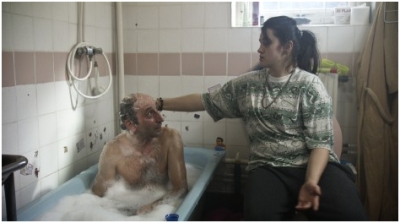
Eat Sleep Die
Another affecting debut film directed by a woman, She Doesn’t Want to Sleep Alone (No quiero dormer sola) from Mexico’s Natalia Beristáin, focuses on familial ties rather than work. But here too the female body resonates in a way that has nothing to do with sexuality. Amanda, the aimless young woman at the center of Beristáin’s film, is drawn out of her aimless existence when her demented alcoholic grandmother Dolores grows too dysfunctional to continue living alone. In the course of her attempts to cope with the situation, Amanda develops a deep empathy with the old woman, a bond that is boldly dramatized when the two inspect one another’s naked bodies in a mirror. Beristáin has commented on how difficult the scene was to film, given that the two actresses, Mariana Gaja (Amanda) and veteran star Adriana Roel (Dolores) “had to bare it all and expose themselves in their flesh, no make-up or beauty filters involved.” But for Beristáin, who, in addition to directing, co-wrote the screenplay with Gabriela Vidal, the scene was a crucial one, because it symbolized the level of trust and acceptance the two women had achieved—even to the point of “getting past the idea that being old means losing your beauty.”
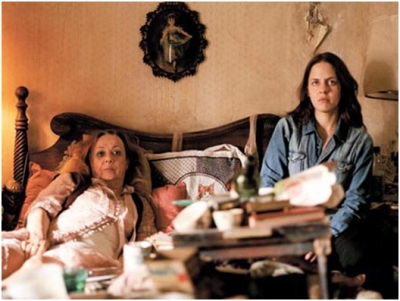
She Doesn’t Want to Sleep Alone
Female nudity was also on display in Love Is all You Need, directed by Oscar winner and Dogme stalwart Susanne Bier. This time the woman in question has cancer. She’s bald and has had a partial mastectomy. No matter. In Bier’s crowd-pleasing romantic comedy, she gets the guy anyway. And the guy is Pierce Brosnan, whose James Bond aura offers much more alluring eye-candy than the everywoman looks of Tryne Dyrholm who plays Ida, his lady-love. The literal meaning of film’s Danish title Den skaldede frisor is The Bald Hairdresser, pointing to the contradiction between Ida’s job as a minion of the beauty industry and her own lost attractiveness. Her damaged body must compete not only with the hunky Brosnan (who, as it happens, lost his own wife to cancer), but also with the picture-postcard setting in the Amalfi coast, where most of the action takes place. Italy as a land of romantic fulfillment has become a cliché of European art cinema, and here Morton Soberg’s luminous wide-screen cinematography shows off what is arguably the most ravishing scenery in the entire Italian peninsula in its full glory. Yet despite all the movie’s visual distractions, Ida draws us to her by the openness of her character and the unaffected honesty of her presence.

Love Is All You Need
Romance and sex were viewed with a more jaundiced eye in two other small-scale films by women on the Venice schedule. Francesca Comencini’s A Special Day (Un Giorno Speciale) focuses on Gina (Guilia Valentini), a comely young woman who is being aggressively marketed as a sex object by her ambitious mother. Gina is set to meet with a congressman who can provide a boost for her nascent acting career in exchange for sexual favors. While she waits for this powerful man to make room for her in his schedule, she drives around Rome with Marco (Filippo Schiccitano), the politician’s naive chauffeur, who shares a background similar to her own. As the day wears on, Gina’s dressy outfit and elaborate hairdo, both orchestated by her over-eager mother, react to the heat and humidity, and the girl begins to look more and more bedraggled. By late in the afternoon, the two young people wander into a chic boutique, and Gina, in a self-destructive gesture of defiance against the world she aspires to enter, absconds with an expensive gown. This incident, along with the other adventures of the day, has the effect of drawing chauffeur and passenger closer together, and an incipient romance develops. But in the end Gina, cowed by her mother’s determination to see her daughter cash in on her good looks, determinedly carries off her assignation with the politician. For her, sex has been defined not as an expression of intimacy and trust, but as a means by which a woman can rise in the social hierarchy.
Like Love Is All You Need, Comencini’s film features widescreen images of touristic hot-spots (courtesy of Luca Bignassi, who shot the movie with lightweight digital cameras that allowed him to capture scenes amid oblivious crowds in iconic locations like the Roman Forum and the Via Condotti). The images in A Special Day, however, refer not to Italy’s scenic splendors but to its storied history and its place in the modern global economy. Given the pointedly nationalistic context conveyed by such visuals it’s not much of a stretch to link the sex-for-advancement bargain made by the hapless Gina and the lecherous politician with the demeaning gender politics Italy as a whole has been associated with under its recent prime minister Silvio Berlusconi.

A Special Day
Sex and romance gets yet another twist of the knife in Turkish writer-director Yesim Ustaoglou’s Somewhere in Between (Araf), in which a young waitress stuck out in the sticks tries to use sex as a means of escape from her dreary surroundings. Zehra (Neslihan Ataguul) chooses as a partner Maheu (Oscan Dennis), a silent truck driver who she fantasizes will carry her off to a better world. But as we view Maheu driving his truck along seemingly endless, featureless highways, he seems as trapped as she is. The difference is that he can’t get pregnant. She can, and does, at which point her lover abandons her. Terrified of her conservative family and community, Zehra tries desperately to conceal her condition. Her dilemma culminates in an unblinkingly rendered bloody scene in a hospital bathroom which makes for an agonizing payoff in a plot that seems to be biding its time up to that point. Following this harrowing climax, Ustaoglu contrives a fantasy scenario of her own to provide the story with a (tongue-in-cheek) happy ending of sorts.

Somewhere in Between
Though the contrarian views of romance, sex and women’s bodies presented in these films are not the sole province of female auteurs, male directors seldom venture into such territory. A more typically male perspective on women was on display in another Venice offering, Passion, a remake of Alain Corneau’s 2010 French thriller Love Crime written and directed by Brian de Palma. Though the plot centers on two women, de Palma has adapted Corneau’s story to appeal to an audience of heterosexual males. To this end he has added generous dollops of female nudity, kinky bedroom activities and lesbian seductions to Coreau’s original story. And in place of the array of anonymous plain janes and compromised female bodies on display in the women’s productions screened on the Lido, de Palma offered up glamorous Hollywood stars Noomi Rapace (The Girl with the Dragon Tattoo) and Rachel McAdams (Sherlock Holmes).
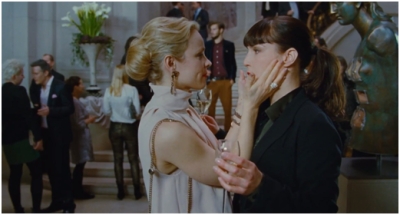
Passion
A more unexpected exercise in the exploitation of female sexuality by a male filmmaker came from Harmony Korine. Korine’s Spring Breakers follows four nubile college girls (played by former Disney stars Selena Gomez and Vanessa Hudgens, joined by Ashley Benson and Korine’s wife Rachel). As the co-eds let out all the stops during their spring vacation in Florida. Intimate scenes featuring the four leads alternate with what looks like footage of the orgiastic partying of actual college undergraduates. This fever dream of a movie, rendered in lurid (shot on 35mm, digitally projected) images courtesy of cinematographer Benoît Debie, seems to be headed towards a dramatic reversal that will belatedly chastise the women for their libidinous excesses. But this is not what happens. Korine is after something else. When the co-eds get busted for drug possession and must appear in court in their bikinis, one feels their vulnerability in the presence of a faceless, unyielding judicial system. When they get bailed out by a local rapper-cum gangster called Alien (James Franco with gold teeth and corn-rows, unrecognizable), things seem to be going from bad to worse for the girls. A more conventional film would have Alien, a hardened career criminal, victimize them. But Alien, unexpectedly, lets the two most conscience-stricken girls go home. He then gives the other two guns, a gesture that infects them with a sense of unbridled omnipotence. One need not be a gun enthusiast to feel a thrill at this moment, for guns equal the playing field of gendered violence. Korine’s actors understood this. “I loved holding a gun,” confessed Benson during the press conference that followed the Venice screening. “It’s so powerful.” In the phantasmagorical world of Spring Breakers, just as in many a male action film, such power carries with it an undeniable sense of freedom.

Spring Breakers
Of course, Venice had its share of male action movies as well, the most macho of which was undoubtedly Takashi Kitano’s yakuza tale Outrage Beyond (Autoreiji: Biyondo), an inventive mash-up of various forms of mayhem involving police, gangsters and a few unwary bystanders. Kitano is a past master of such spectacles, putting his own spin on the genre by spiking the goings-on with mordent humor while sparing his audiences the worst of the gore. As several reviewers observed, the convoluted plot of Kitano’s latest outing was hard to follow, but what did it matter as long as the carnage continued? An awesome array of excruciating sound effects enhanced the proceedings, all of which the festival’s state-of-the-art audio system reproduced with crystalline clarity. An execution at a carnival baseball concession was perhaps the highlight of this fun-house of murder and maiming. “Beat” Kitano, as the filmmaker’s acting persona is known, plays the “hero,” a world-weary gangster who presides over much of the pandemonium wearing a fixedly bemused expression.
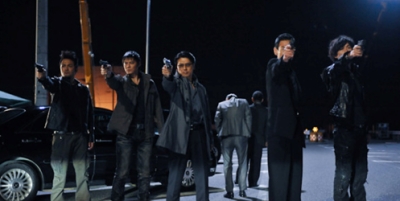
Outrage Beyond
If Laura Mulvey reduced cinematic women to erotic spectacles, she also pigeonholed men as figures who drive narratives forward according to a principle of logical progression. As Outrage Beyond showed only too well, however, males need not be logical any more than women need to be objectified. Kitano’s movie stood as a superior example of the species of male melodrama in which excess takes the form not of a display of female bodies but the eruption of violent set-pieces haphazardly cobbled together into what passes for a plot. Insofar as there could be said to be an ideology behind such scenarios it resides in the rigidly hierarchical structures and the take-no-prisoners spirit of competition and status-seeking which underpins the patriarchal world this cinema depicts.
Yet the Venice program also managed to make room for a contrarian men’s movie to stand beside its women’s films. A Hijacking (Kapringen), written and directed by Danish Tobias Lindholm, took a typical thriller plot and turned it on its head. When a large freighter in the Indian Ocean is captured by Somalian pirates, the company’s steely head honcho Peter (Søren Malling) must negotiate for the ship’s return and the release of its crew. But, in a daring reversal of the expectations its title sets up, Lindholm declines to show us the actual hijacking. Instead, he focuses on the human price that is paid as a result of the disaster. As a result of the stress he finds himself under, Peter destroys his marriage; and the ship’s sweet-tempered cook Mikkel (Pilou Asbǽk), cruelly separated from his young family for a period of months without any assurance that he will ever see them again, begins to fall apart. As negotiations drag on, Magnes Nordenhof Jønck’s cinematography provides a visible correlative to these interior dramas taking place, contrasting the cramped, grubby interior of the ship, where the crew is interred, with the cold, glass-filled corporate headquarters, where Peter conducts the negotiations.
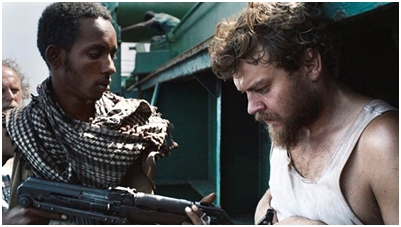
A Hijacking
Martha Lauzen’s research on gender in the media covers not only moviemakers but also movie reviewers. Here, too, she discovered an imbalance. Only 23% percent of all reviewers are female, and women who do hold such positions tend to have less prestigious job titles and publish fewer pieces than their male counterparts. By contrast, women are well represented as film scholars in academia, where a culture that relies on credentials and strict hiring protocols minimizes the effects of male cronyism and gender bias. Such bias can take many forms, as I observed at another recent festival in Bologna, when those of us in the audience for a series of four panels on cinephilia were informed that no qualified women could be found to serve as discussants. Another recent case concerned a new biography of the critic Pauline Kael in which there is no mention of her charges of sexism against Andrew Sarris and the early auteurists.
A less concrete but more insidious result of such lopsided gender representation in the reviewer community is its effect on the kind of reviews that get written. Movies directed at male audiences are more likely to be favored. And many movies will be viewed through a masculine lens. For example, Terrence Malick’s new film To the Wonder, which premiered on the Lido, was described by at least two male critics as a story centered on Neil (Ben Affleck)—even though Neil scarcely speaks and remains largely an enigma. In contrast, most of the film’s voice-over narration is presented by Marina (Olga Kurylenko), who also occupies more screen time and is the only person who undergoes a significant change as the story progresses. Chances are a female critic would have seen the story differently.
What was most disquieting about commentary from the male community of reviewers at the Venice event, however, was their response to the festival as a whole. Despite the major commitment shown by Barbera and his staff in deciding to feature films by women, I found scant critical commentary on the women’s films that were screened. Moreover, not a single journalistic round-up piece I encountered saw fit to mention the festival’s focus on women, preferring instead to single out the religious motifs present in many of the films in competition, the squabbling that took place on the jury over Paul Thomas Anderson’s The Master, and the ire of Italian auteurs who felt themselves snubbed when the prizes were handed out. Yet there were many women in the audience of this year’s festival who took heart from the panoply of women’s films on the program. On behalf of all of them I say, “Bravo, Alberto Barbera! Your efforts were not in vain.”
Work Cited
Lauzen, Martha. Center for the Study of Women in Television and Film.

